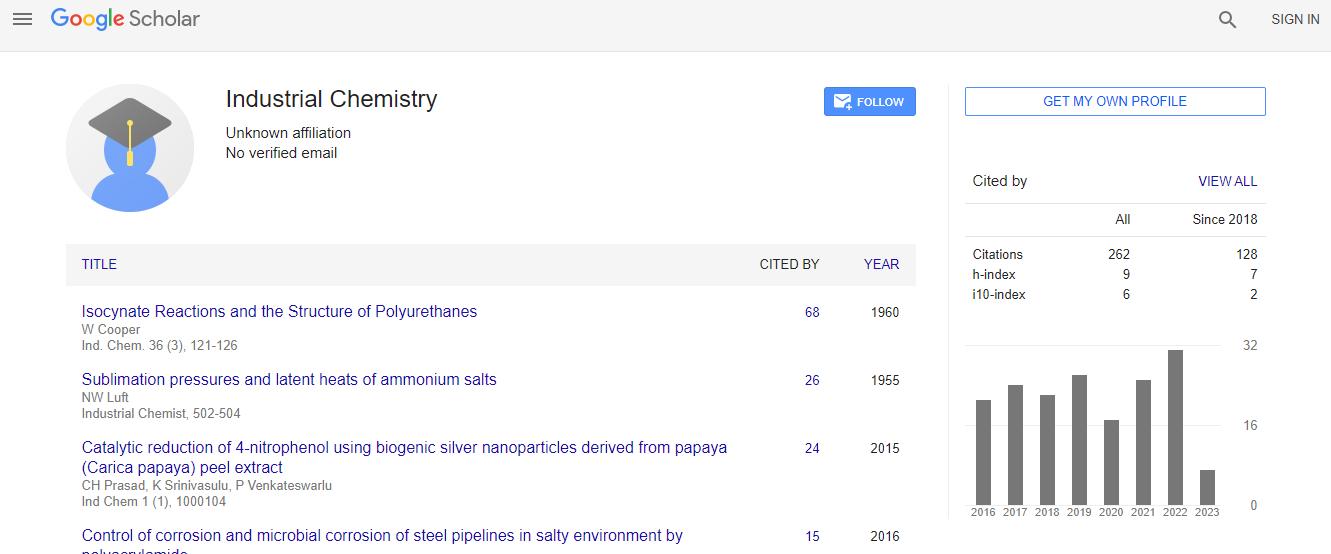Our Group organises 3000+ Global Conferenceseries Events every year across USA, Europe & Asia with support from 1000 more scientific Societies and Publishes 700+ Open Access Journals which contains over 50000 eminent personalities, reputed scientists as editorial board members.
Open Access Journals gaining more Readers and Citations
700 Journals and 15,000,000 Readers Each Journal is getting 25,000+ Readers
Google Scholar citation report
Citations : 262
Industrial Chemistry received 262 citations as per Google Scholar report
Indexed In
- Index Copernicus
- Google Scholar
- RefSeek
- Directory of Research Journal Indexing (DRJI)
- Hamdard University
- EBSCO A-Z
- OCLC- WorldCat
- Scholarsteer
- Geneva Foundation for Medical Education and Research
- Euro Pub
Useful Links
Recommended Journals
Related Subjects
Share This Page
Decontamination of polluted water by veterinary antibiotics by studying the photochemical behavior under light excitation
2nd World Conference on Industrial Chemistry and Water Treatment
Soumaya Mezghich, Fadhila Ayari, Dalila Ben Hassen Chehimi and Mohamed Sarakha
University of Carthage, Tunisia Blaise Pascal University, France
ScientificTracks Abstracts: Ind Chem
Abstract
Nowadays, the emergence of pharmaceuticals in the aquatic and terrestrial environment has been a major concern. They have been detected in sewage-treatment plants, sediments, and soils, as well as, at surface and drinking water. So far, there is limited information in the literature on the fate of these compounds when they are exposed to solar light in the various environmental compartments. The objective of the present study is to investigate the degradation process of two different antibiotics Sulfamethoxazole (STZ), Hydrochlorothiazide (HCD) in aqueous solutions when exposed to simulated solar light. We mainly concentrate our effort on the kinetic studies by evaluating the degradation quantum yield, as well as, the effect of various parameters such as oxygen concentration, pH and the presence of inorganic ions. The main effect was observed by molecular oxygen parameter. We also make an important effort in the elucidation of the main intermediate and stable byproducts. A lot of information is available on the stability and fate of parent compounds and not so many on their transformation products. These may present a toxicity level higher than the precursor substrate and should be identified and analyzed. The structure elucidation was obtained by using the HPLC/ESI/MS and HPLC/ESI/MS2 techniques in negative, as well as, positive modes and through the complete study of the various fragmentation pathways. The main involved photochemical processes were: The scission of the bridge through a photohydrolysis process, selective hydroxylation of the aromatic moiety, desulfonation process and in the case of HCD to dechloration reaction. A mechanism was then proposed in the light of the kinetic and analytical studies.Biography
Email: soumaya.mezguich@gmail.comt

 Spanish
Spanish  Chinese
Chinese  Russian
Russian  German
German  French
French  Japanese
Japanese  Portuguese
Portuguese  Hindi
Hindi 